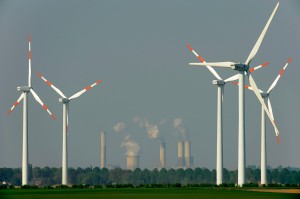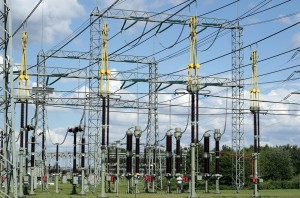Change, Challenges and Chances
Hardly any other neo-logism has enjoyed such a fast-tracked career in recent years as the term Energiewende or energy revolution. Energiewende is the term for the joint efforts of government, industry, and society to reverse the present 20 percent renewable and 80 percent conventional electricity generation supply by the year 2050. The word Wende, literally ‘turning point’ in German, harks back to the political transformations during the peaceful revolution after the fall of the Berlin Wall in 1989.
As early as September 2010, the Federal Government had set out its plan for the transition towards renewable energy in its so-called “Energy Concept 2050.” The nuclear disaster in Fukushima two years ago however was to mark another watershed in the German discussion on energy policy. In June 2011, the Federal Government decided to immediately shut down eight nuclear power plants, with nine more to follow in stages up until 2022.
Goals of the Energiewende
Despite the difficulties and heated discussions, Germany’s energy industry has supported the goals of the Energiewende right from the start. The plan seeks to reduce greenhouse gas emissions by up to 40 percent by 2020, 55 percent by 2050, 70 percent by 2040, culminating in an 80–95 percent reduction of 1990 levels by 2050. During this same period, steps will be taken to reduce primary energy consumption to 50 percent of its 2008 level. In 2009, the energy industry as organised under the BDEW, the German Association of Energy and Water Industries, had already set the goal of achieving CO2 neutral energy supply by 2050.
Conventional power plants remain important
It is becoming increasingly clear that the Energiewende will be an enormous feat, one that cannot be accomplished in a few years. There is a wide spectrum of issues to be addressed and goals to be achieved if it is to be realized. The most important fields of activity are the expansion of the electrical grid, increasing the use of renewable energies, and better integration of renewables into the energy mix. Building conventional power plants will be critical to preserve the stability of the system.
Building new and modern conventional power plants is inescapable for a successful transition to renewable energy sources. If the proportion of energy generated from renewable sources increases substantially, the need for power plants which can be rapidly taken on- and offline to match demand will increase accordingly. Conventional plants are a basic prerequisite for a secure supply of electricity when the wind is not blowing or the sun is not shining. Over time, production at these plants will decrease; meaning their capacity to pay for themselves will also diminish. This is largely already happening today and the situation is set to intensify in the coming years. One of the primary topics in the current energy debate in Germany is how the energy market can be designed so that the expansion of renewable energies can be brought into balance with the continuing necessity for conventional power plants.
Planners will also have to take into account the steadily increasing cost of building or expanding power generation plants which use renewable energy sources. Electricity consumers in Germany will have to spend an estimated €20.4 billion ($26 billion) in 2013 to pay for renewable energy subsidies under the German Renewable Energies Act. It is now a matter of the utmost priority that subsidy programs for renewable energy are made as efficient as possible. Reform on this issue will be unavoidable.
New grids are needed
A further central component of the energy revolution is the required expansion and restructuring of the electrical grid. The enhanced use of renewable
energies called for by the Energiewende will force the decentralization of power generation. At present, more than 90 percent of the electricity generated using renewable resources is fed into the distribution grid from individual sources and must be transported to other regions. As a result, the network will have to be extended and over the next decade some €20 billion ($25 billion) will be required for this.
Without new extra-high voltage lines, it will also not be possible to transport wind power, produced primarily in the north, to the consumption centers in western and southern Germany.
One of Europe’s most important industrial projects
In November of 2012, the German agency responsible for the regulation of the electrical grid, the Bundesnetzagentur, acknowledged the need for 5,700 kilometers (3500 miles) of new electric lines at the high and extra-high voltage levels.
One very critical aspect of any expansion and improvement to existing infrastructure on this scale is the acceptance of these measures by the public. The Energiewende will change the face of the country. Whether they are dealing with wind farms, new networks, pumped-storage hydroelectric plants, biogas plants, or similar projects, local populations often have serious concerns about new energy infrastructure plans. Just a decade ago, little more than 120 to 130 mid-sized and large power generation units were sufficient to secure the entire energy supply of Germany. Today, the Federal Network Agency lists over 1,600 power plants rated at 10 megawatts or more. By the end of 2012, a total of around 8,000 biogas plants, 23,000 wind power facilities, and 1.3 million photovoltaic systems had been installed in Germany. This means that energy production is becoming much more visible than it was in the past. One thing is clear for the industry: Building a sustainable energy system based on renewable resources and creating the necessary infrastructure will only succeed if the public understands and accepts the rationale for the future energy policies.
One thing is for sure, we must not only look to Germany to revolutionize the generation of power. The broader European perspective will have to be taken into consideration. It will be essential to incrementally harmonize the expansion of renewable energies across Europe in the long term. The goal is to move away from targeted support for specific technologies toward a cost-effective exploitation of potential energy resources wherever it makes the most sense within Europe. This offers the opportunity for significant financial savings within European economies. However, geopolitical developments like the so-called ‘shale gas’ revolution and the accompanying energy independence goals of the United States must also be considered, as they are already having a palpable influence on the international energy markets.
Because it is so far-reaching, the Energiewende could become one of the most important industrial policy projects of our time – and not just in Germany.
Hildegard Müller is chairwoman of the General Executive Management Board and member of the Executive Board of the German Association of Energy and Water Industries (Bundesverband der Energie- und Wasserwirtschaft, BDEW) in Berlin


